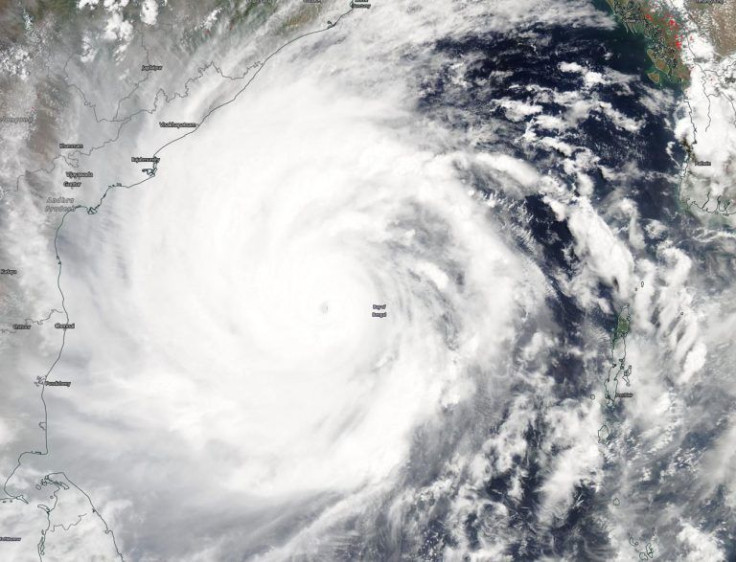Amid Covid-19 Pandemic, Eastern India, Bangladesh Brace For Deadly Cyclone Amphan

KEY POINTS
- On Monday, Amphan was the most powerful storm ever recorded in the Bay of Bengal
- As of Tuesday evening (local time), Amphan had maximum sustained winds of 132 mph
- The cyclone will bring torrential rain, damaging winds and extreme storm surge directly to Kolkata
Amid the coronavirus pandemic, northeastern India and Bangladesh are preparing for one of the strongest cyclones ever recorded in the Bay of Bengal
Super Cyclone Amphan, which is expected to make landfall on Wednesday, has prompted local authorities to evacuate millions of people from the storm’s deadly path.
The U.S. Joint Typhoon Warning Center said that on Monday evening Amphan boasted sustained wind speeds of up to 270 kilometers per hour (165 miles per hour), making it the most powerful storm ever recorded in the Bay of Bengal.
As of Tuesday evening (local time), Amphan had maximum sustained winds of 132 mph, the equivalent of a strong Category 4 hurricane in the Atlantic Ocean.
The cyclone will bring torrential rain, damaging winds and extreme storm surge directly to Kolkata, a city of some 14 million people.
“Due to the widespread low elevation across southern Bangladesh and southern West Bengal, coastal flooding will be a major concern as winds push water from the Bay of Bengal onshore," stated AccuWeather Senior Meteorologist Adam Douty.
Douty added that significant flooding will occur across northeastern India, Bhutan and northern Bangladesh, while mudslides are very possible in the eastern Himalayans and the Garo-Khasi mountains in Meghalaya, India.
The US Pacific Disaster Center said up to 33.6 million people in India could be in the path of the cyclone’s winds, while up to 5.3 million could be vulnerable in Bangladesh.
The last super cyclone in the area, Odisha in late 1999, killed at least 15,000 people.
Indian authorities said up to 300,000 people living in the coastal regions of West Bengal and Odisha state are now in immediate danger from the cyclone. Local officials have commenced evacuation procedures.
However, the pandemic complicates matters.
Satya Narayan Pradhan, Director General of the National Disaster Relief Force said in the province of West Bengal about 500,000 people can be housed in cyclone shelters -- but due to social distancing rules, they only have enough room to house about 200,000 people fleeing the storm.
Pradhan also warned that the areas under greatest threat from the storm were less developed and poor, with many residents living in homes with thatched or tin roofs.
"[All National Disaster Relief Force workers] have to be masked, everyone has to wear visor, gloves ... It's almost certain that they will be going to do rescue work in red [heavily-infected] zones ... They may be actually rescuing people who are already infected. It is a double challenge," Pradhan said.
S.G. Rai, a disaster management official in India, told Reuters: "The cyclone could wash away thousands of huts and standing crops."
Pradeep Jena, special relief commissioner for Odisha state said: "We have to strike a balance between the two [crises] and evacuate people wherever it is extremely essential, otherwise people are better off in their own homes."
In Odisha, 250 of the more than 800 existing shelters are currently being used as coronavirus quarantine centers.
Jena added: “Social distancing is definitely a very good concept but enforcing it in the strictest possible manner in a disaster situation may not always be possible.”
Indian Prime Minister Narendra Modi tweeted: “Reviewed the preparedness regarding the situation due to cyclone ‘Amphan.’ The response measures as well as evacuation plans were discussed. I pray for everyone's safety and assure all possible support from the central government.”
In Bangladesh, Disaster Management Junior Minister Enamur Rahman said the nation was expecting to evacuate about 2 million people from coastal regions to more than 12,000 cyclone shelters.
“We have taken necessary steps so that people can maintain distance and wear masks," said Rahman.
The Bangladesh Disaster Management Ministry's senior information official Selim Hossain said they have room for a total of 9.1 million people to be housed in cyclone shelters while also observing social distancing measures.
However, it is unclear if all evacuees even want to be transported to shelters.
“In the [Bhola] district, there are 21 risky remote islands, on which around [300,000] people are living. Most of them don't want to go to the cyclone shelters. But we will try to bring in as many as possible [to the shelters]," said Mohammed Masud Alam Siddique, deputy commissioner of Bhola in Bangladesh.
Amphan will also likely pound the largest refugee center in the world in Bangladesh’s Cox's Bazar, where about 1 million Rohingya refugees live having fled violence in neighboring Myanmar. Last week, the camp confirmed its first coronavirus cases.
"The prevalence of underlying health conditions among refugees and the deteriorating sanitary conditions sure to come with the looming monsoon and flooding season make for a witch's brew of conditions in which the virus is sure to thrive," said Daniel P. Sullivan of the U.S.-based Refugees International.
Snigdha Chakraborty, an official of Catholic Relief Services, warned: “There are no evacuation shelters in the camps and we are worried about damage from flooding, wind and risk of COVID-19.”
© Copyright IBTimes 2025. All rights reserved.





















